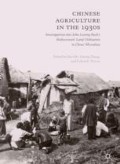Abstract
The relationship between farm size and land productivity is a disputed one in the field of agricultural development. Based on the original data of Buck’s rural social survey, this study has calculated the land productivity differences of small, small and median, median, median and large, and large farms to verify the argument that small farms have an advantage and explore household behavioral differences and labor market characteristics. The results suggest that imperfect labor markets primarily cause an inverse size–productivity relationship; however, household behavior differences are also considered.
Access this chapter
Tax calculation will be finalised at checkout
Purchases are for personal use only
Notes
- 1.
Buck, Chinese Farm Economy (the Chinese Version), p. 8.
- 2.
Buck, Land Utilization in China (the Chinese Version), Nanjing, 1937, pp. 8.
- 3.
Buck, Land Utilization in China (the Chinese Version), Nanjing, 1937, pp. 516–517.
- 4.
Taking the arithmetic average of farm area per capita in each area as a based, the 25% standard deviation as the group distance, the group with the median was the median farm. Meanwhile, there were small & medium-sized farmers and small farmers downward, and median & large and large farms upward.
- 5.
Buck, Land Utilization in China: Statistics (the Chinese Version), Nanjing, 1937, pp. 211.
- 6.
Buck, Chinese Farm Economy (the Chinese Version), p. 222.
- 7.
Buck, Land Utilization in China (the Chinese Version), p. 361.
- 8.
Buck, Chinese Farm Economy (the Chinese Version), pp. 317–319.
- 9.
Buck, Land Utilization in China (the Chinese Version), p. 235.
- 10.
Buck, Land Utilization in China (the Chinese Version), p. 305.
- 11.
Buck, Land Utilization in China (the Chinese Version), p. 303.
References
Ahmed, I. 1981. Farm Size and Labor Use: Some Alternative Explanations. Oxford Bulletin of Economics and Statistics 43 (1): 73–88.
Alvarez, A., and C. Arias. 2004. Technical Efficiency and Farm Size: A Conditional Analysis. Agricultural Economics 30 (3): 241–250.
Barrett, C.B., M.F. Bellemare, and J.Y. Hou. 2010. Reconsidering Conventional Explanations of the Inverse Productivity–Size Relationship. World Development 38 (1): 88–97.
Benjamin, D. 1995. Can Unobserved land Quality Explain the Inverse Productivity Relationship? Journal of Development Economics 46 (1): 51–84.
Benjamin, D., and L. Brandt. 1995. Markets, Discrimination and the Economic Contribution of Women in China: Historical Evidence. Economic Development and Cultural Change 1995: 63–104.
———. 1997. Land, Factor Markets, and Inequality in Rural China: Historical Evidence. Explorations in Economic History 34 (2): 460–494.
———. 2002. Property Rights, Labor Markets, and Efficiency in a Transition Economy: the Case of Rural China. Canadian Journal of Economics 35 (4): 689–716.
Bhalla, S.S., and P. Roy. 1988. Mis-specification in Farm Productivity Analysis: The Role of Land Quality. Oxford Economic Papers 40: 55–73.
Chayanov, A.V. 1986. The Theory of Peasant Economy. Madison: University of Wisconsin Press.
Chen, Hansheng. 1985. The Chinese Peasants. Shanghai: Fudan Press.
Chen, Z., W.E. Huffman, and S. Rozelle. 2011. Inverse Relationship Between Productivity and Farm Size: the Case of China. Contemporary Economic Policy 29 (4): 580–592.
Elvin, M. 1973. The Pattern of the Chinese Past: A Social and Economic Interpretation. Palo Alto, CA: Stanford University Press.
Feder, G. 1985. The Relation Between Farm Size and Farm Productivity: the Role of Family Labor, Supervision and Credit Constraints. Journal of Development Economics 18 (2–3): 297–313.
Fu, H., and C.G. Turvey. 2018. The Evolution of Agricultural Credit During China’s Republican Era, 1912–1949. Cham: Palgrave Macmillan.
Hou, Jianxin. 2001. Agricultural Labor Productivity in Central Part of Hebei Province in early 20th Century. Chinese Agriculture History 1: 57–67.
Huang, P. 1985. The Peasant Economy and Social Change in North China. Stanford, CA: Stanford University Press.
Li, Chenggui. 1997. Resource Allocation and Efficiency Level of Traditional Agriculture. Chinese Agriculture History 1: 74–83.
Nurkse, R. 1952. Some International Aspects of the Problem of Economic Development. The American Economic Review 42 (2): 571–583.
Sen, A.K. 1966. Peasants and Dualism with or Without Surplus Labor. Journal of Political Economy 74 (5): 425–450.
Wang, Siming. 1998. Conditions and Constraints: Resources, Technology, Institutions and Culture—An Analytical Framework for the Study of Agricultural Development. Chinese Agriculture History 1: 73–80.
Wen, Liming. 2011. The Failure of Agricultural Capitalism in the Western Countries in the Late Twentieth Century and Early Nineteenth Century. Journal of Suzhou University of Science and Technology 7: 59–65.
Author information
Authors and Affiliations
Corresponding author
Editor information
Editors and Affiliations
Appendix: Detailed Production Coefficients
Appendix: Detailed Production Coefficients
Rights and permissions
Copyright information
© 2019 The Author(s)
About this chapter
Cite this chapter
Hu, H., Yu, M. (2019). The Relationship Between Farm Size and Land Productivity in Early Twentieth-Century China. In: Hu, H., Zhong, F., Turvey, C. (eds) Chinese Agriculture in the 1930s. Palgrave Macmillan, Cham. https://doi.org/10.1007/978-3-030-12688-9_10
Download citation
DOI: https://doi.org/10.1007/978-3-030-12688-9_10
Published:
Publisher Name: Palgrave Macmillan, Cham
Print ISBN: 978-3-030-12687-2
Online ISBN: 978-3-030-12688-9
eBook Packages: Economics and FinanceEconomics and Finance (R0)

